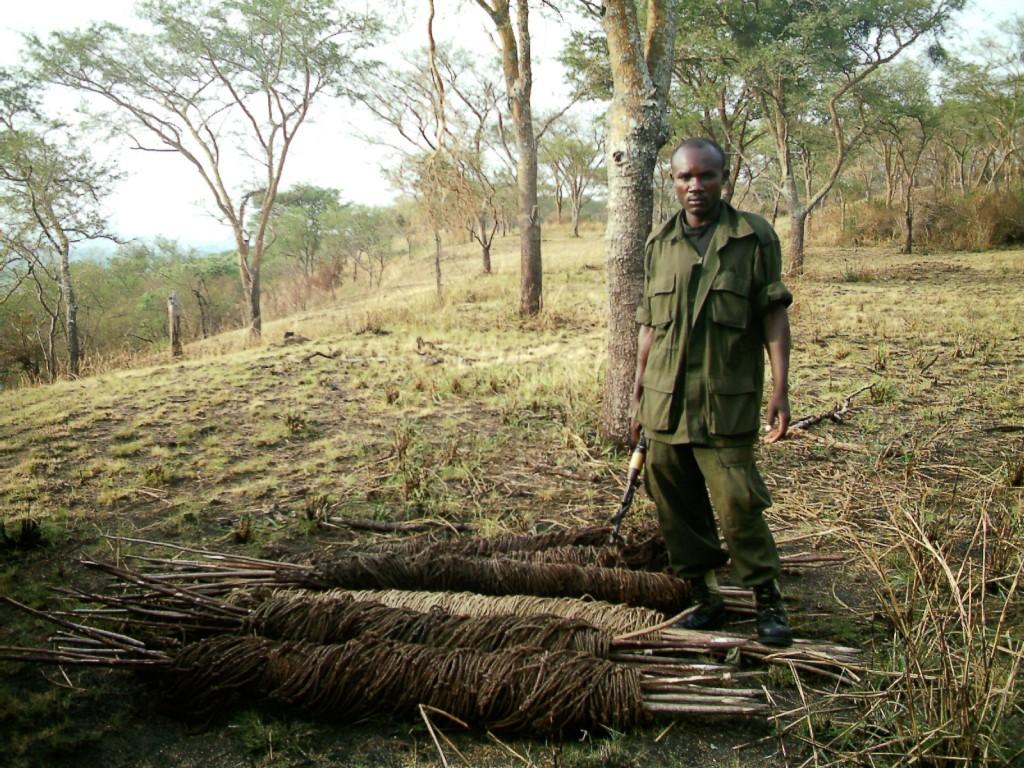BUSHMEAT HUNTING
Bushmeat is meat from wild animals hunted in Africa and Asia, but it has particularly been used to refer to meat from animals traded in West and Central Africa markets. Harvesting of wildlife for meat is a major threat to conservation and a potential hindrance to achievement of the full benefit of wildlife resources. Illegal bushmeat hunting in Africa is conducted for two primary reasons, i.e. food and income. Although law enforcement is essential to protecting wildlife from illegal poaching,pressures such as landlessness, crop and livestock loss to wild animals, and bushmeat trade for income, which drive bushmeat hunting must be addressed by national governments. Conservationists highly recognize poaching and wildlife trafficking as a big challenge to conservation, but the problem had rarely been framed as a bushmeat issue.
 With funding from USAID, WCS researchers (Olupot, McNeilage, and Plumptre, 2009) undertook a study to analyze the socioeconomics of bushmeat hunting in Uganda, focusing on major hunting sites namely: Kampala, a major urban center, Queen Elizabeth Conservation Area (QECA), Rwenzori Mountains National Park (RMNP), Murchison Falls Conservation Area (MFCA), and Kafu River Basin which represent a broad range of habitats from savanna to woodland to forest. The goals and objectives of this survey were to:
With funding from USAID, WCS researchers (Olupot, McNeilage, and Plumptre, 2009) undertook a study to analyze the socioeconomics of bushmeat hunting in Uganda, focusing on major hunting sites namely: Kampala, a major urban center, Queen Elizabeth Conservation Area (QECA), Rwenzori Mountains National Park (RMNP), Murchison Falls Conservation Area (MFCA), and Kafu River Basin which represent a broad range of habitats from savanna to woodland to forest. The goals and objectives of this survey were to:
1) understand the extent of bushmeat hunting for both subsistence and commercial needs around centers of wildlife in Uganda
2) asses social economic factors that drive the bushmeat market;
3) asses market chain and the role the trade plays in households livelihoods;and
4) investigate the link between crop raids and bushmeat harvesting.
Olupot, McNeilage, and Plumptre(2009) noted that the major causes of bushmeat hunting varied between communities. Major wild animals hunted ranged from large-to-medium sized mammals such as Uganda kobs, bush pigs, bushbucks, hippopotamus, waterbucks,buffaloes, warthogs, duikers, baboons, giant forest hogs, arboreal monkeys,porcupines, cane rats, and guinea fowls.
People reported consuming bushmeat because it is affordable than livestock meat, tasty, culturally and traditional attachments, and for trophies, therapeutic and medicinal values. The key findings were that:
i) bushmeat was not the main source of meat for an average household living in and around major hunting sites, with less than 32% of the households consuming meat, and these were mainly the wealthy households;
ii)bushmeat was the main source of meat for hunters, contributing significantly to their household income;
iii) most of the bushmeat was locally consumed in the communities adjacent to the parks;
iv) income, and crop raiding and other forms of human-wildlife conflicts are not necessarily the main drivers of bushmeat hunting.In this study, the authors made a number of recommendations that the government of Uganda, particularly UWA need to undertake. These are: the need for sustained law enforcement as a main deterrent,establishment of wildlife barriers and use wildlife guards to keep animals inside protected areas; conduct community environmental education and awareness;set up a strategic plan for utilization of wildlife on privately owned land in wildlife rich areas; provide alternatives to bushmeat as well as income generating activities; improved wildlife policy and strengthening of the legislation and regulation of wildlife use; and the need for more research in other parts of the country to determine the intensity of off-take and major drivers of bushmeat hunting; technical capacity building through training of wildlife managers.
WCS is proud to be part of the process that culminated into Bushmeat-Free Eastern Africa Network (BEAN) (http://www.bushmeatnetwork.org/index.html),an interdisciplinary network that is focused on bringing wildlife departments and organizations together to address this complex multi-disciplinary challenge;
